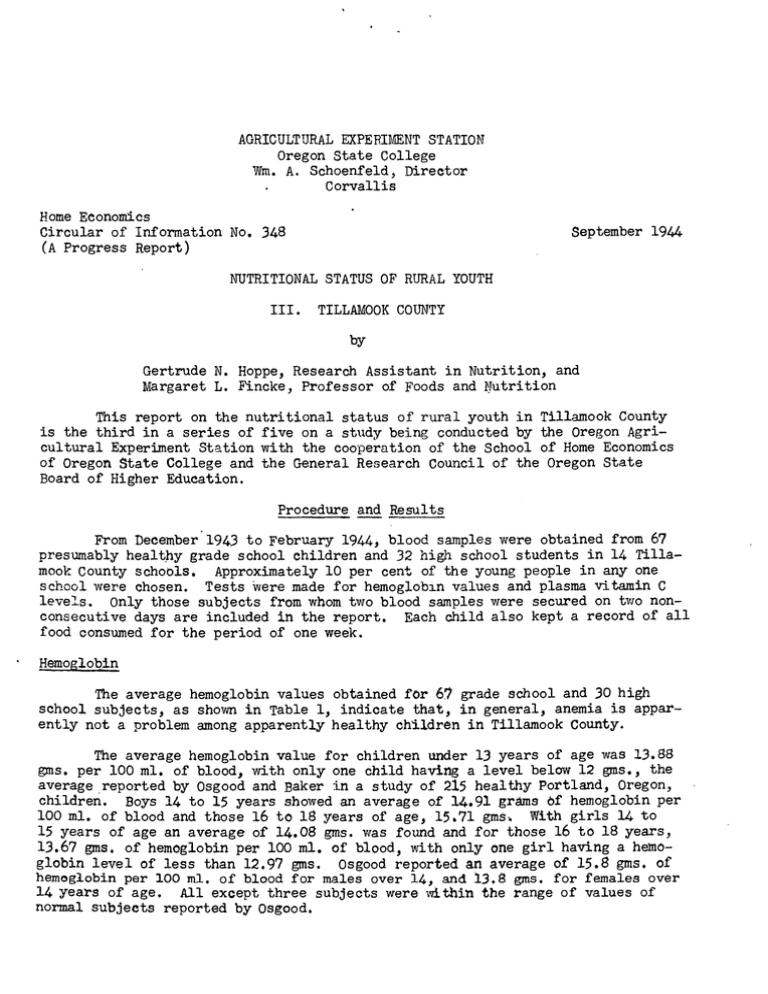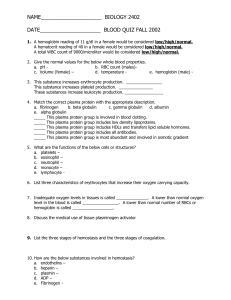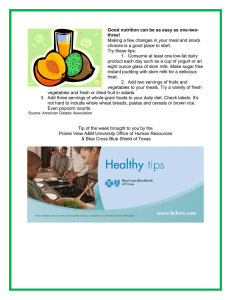AGRICULTURAL EXPERIMENT STATION Oregon State College Wm. A. Schoenfeld, Director Corvallis
advertisement

AGRICULTURAL EXPERIMENT STATION Oregon State College Wm. A. Schoenfeld, Director Corvallis Home Economics Circular of Information No. 348 (A Progress Report) September 1944 NUTRITIONAL STATUS OP RURAL YOUTH III. TILLAMOOK COUNTY by Gertrude N. Hoppe, Research Assistant in Nutrition, and Margaret L. Fincke, Professor of Foods and Nutrition This report on the nutritional status of rural youth in Tillamook County is the third in a series of five on a study being conducted by the Oregon Agricultural Experiment Station with the cooperation of the School of Home Economics of Oregon State College and the General Research Council of the Oregon State Board of Higher Education. Procedure and Results From December 1943 to February 1944, blood samples were obtained from 67 presumably healthy grade school children and 32 high school students in 14 Tillamook County schools. Approximately 10 per cent of the young people in any one school were chosen. Tests were made for hemoglobin values and plasma vitamin C levels. Only those subjects from whom two blood samples were secured on two nonconsecutive days are included in the report. Each child also kept a record of all food consumed for the period of one week. Hemoglobin The average hemoglobin values obtained for 6? grade school and 30 high school subjects, as shown in Table 1, indicate that, in general, anemia is apparently not a problem among apparently healthy children in Tillamook County. The average hemoglobin value for children under 13 years of age was 13.88 gms. per 100 ml. of blood, with only one child having a level below 12 gms., the average reported by Osgood and Baker in a study of 215 healthy Portland, Oregon, children. Boys 14 to 15 years showed an average of 14.91 grams 6f hemoglobin per 100 ml. of blood and those 16 to 18 years of age, 15.71 gms-. With girls 14 to 15 years of age an average of 14.08 gms. was found and for those 16 to 18 years, 13.67 gms. of hemoglobin per 100 ml. of blood, with only one girl having a hemoglobin level of less than 12.97 gms. Osgood reported an average of 15.8 gms. of hemoglobin per 100 ml. of blood for males over 14, and 13.8 gms. for females over 14 years of age. All except three subjects were within the range of values of normal subjects reported by Osgood. Table 1. Hemoglobin Values for Age and Sex. Tillamook County. Grams of Hemoglobin per 100 ml. of blood Average Range Age and Sex No. Subjects 8-13 years Boys Girls 30 30 13.89 13.87 12.83-15.56 11.28-15.38 14-15 years Boys Girls 10 15 14.91 14.08 13.45-16.15 12.97-15.18 )-18 years Boys Girls 4 8 15.71 13.67 15.01-16.56 9.34-14.83 ' Blood Plasma Vitamin C o Blood plasma vitamin C values were determined for 55 grade school and 32 high school students. Sixty-eight per cent of the grade school children and 71 per cent of the high school had plasma levels below 0.60 mg. of ascorbic acid (vitamin C) per 100 ml. of plasma, which has been judged as adequate by the Committee on Vitamins of the American Academy of Pediatrics (1940). For optimal nutrition the level should be at least 0.80 mg". per 100 ml. of plasma. The average plasma ascorbic acid level for grade school children was 0.48 mg. per 100 ml. of plasma, while that for high school students was 0.41 mg. Table 2. Comparison of Blood Plasma Ascorbic Acid (Vitamin C) Values of Grade and High School Children—Tillamook County No. Subjects Mo. subjects with values below 0.60 mg. Average Plasma Ascorbic Acid mg./JOO ml. Ranges Grade school 55 37 0.48 0.12-1.04 High school 32 23 0.41 0.14-0.95 The difference between ascorbic acid plasma levels of the two sexes within age groups was not nearly so great as that between age groups. The highest average level was 0.62 mg. of ascorbic acid per 100 ml. of plasma for children under 11 years, the older children all showing lower average values. Table 3. Plasma Ascorbic Acid (Vitamin C) Levels of Boys and Girls at Different Age Levels. Expressed as mg. of Ascorbic Acid per 100 ml. of Plasma Boys Girls Total Ave. No. Subj. No.. Subj^ Ave. No . Subjij, Ave. 7 0,57 5 0..68 12 0.62 12 to 13 yrs. 20 0.50 18 0.45 38 0.48 14 to 15 yrs. 9 0*21 17 0.44 26 0.36 16 to 17 yrs. 4 0.36 7 0.51 11 0.43 Age Group Less than 12 yrs. Food Consumption Records A high plasma ascorbic acid level in individual students was correlated with a high consumption of citrus fruits and tomatoes. Because, in general, the consumption of other raw fruits and vegetables was quite low, their consumption did not exert much influence on the plasma ascorbic acid level. Table 4. Relationship of Numbers of Servings of Fruits and Vegetables per Week and Plasma Vitamin C Values in Different Age Groups Mg, of ascorbic acid per 100 ml. of plasma Citrus fruit and tomatoes Other raw fruits and vegetables Total citrus fruit, tomatoes and other raw Other fruits and vegetables Less than 12 yrs. 0.62 4.31 4.46 8.77 21.93 12 to 13 yrs. 0.48 4.01 4,68 8.64 18.24 14 to 15 yrs. 0.36 4.72 3.44 8,16 17.37 16 to 17 yrs. 0.43 3.46 6.12 9.58 17.83 Age Group The varieties of vegetables eaten were not great, green beans, corn, peas, carrots, cabbage, lettuce, and dried beans occurring most often on the list. Few green leafy vegetables were found. Spinach occurred only 11 times in 651 days, sprouting broccoli 10 times and Brussels sprouts once. An average of 14,1 glasses of milk per week or just about a pint of milk a day was consumed by these TillamooH County children. The range of milk eonsumption was from 0 to 34 glasses per week. This includes milk on cereal, milk shakes, and milk drinks as well as milk, although it does not include milk used in cooking. Uie average cheese consumption was one serving a week. On the whole, meat, fish and poultry consumption was fairly high—an average of 10,9 servings a week. Table 5. Consumption of Milk, Egg, Meat, Fruits and Vegetables Average number of servings per week Food U.l Milk and cream Cheese 1.0 Eggs 3.9 Meat, fish and poultry 10.9 Citrus fruits and tomatoes . 4.3 Raw vegetables Lettuce cabbage carrots celery mixed raw salads and other 1.7 0.6 0,3 0.4 0,2 0,2 Raw fruits other than citrus apples 1.9 other 0,4 2.3 Potatoes 7.3 Cooked and canned vegetables 7.0 Dry peas and beans 1.1 Cooked, canned and dried fruits 5.8 Table 6. Total Number of servings of Fruits and Vegetables Records of 651 days by 94 children Food Citrus fruits-total oranges grapefruit lemons Tomatoes-total tomatoes tomato soup Potatoes Raw vegetables-total lettuce carrots cabbage celery others Cooked vegetables-total green beans corn peas carrots vegetable soup beets vegetable salad carrots and peas squash sauerkraut cabbage spinach broccoli onions parsnips cauliflower asparagus turnips rutabagas wilted lettuce pumpkin celery and carrots Brussels sprouts No. Servings 287 202 74 11 133 111 22 677 165 55 39 30 24 17 651 123 98 96 71 68 25 25 22 19 18 15 11 10 9 8 7 6 6 4 1 1 1 1 Food Dry peas and beans-total navy beans lima beans red beans soy beans split pea soup Raw fruits-total apples bananas grapes strawberries Canned, cooked, or dried fruits-total peaches mixed fruits and salad fruit desserts apples pears prunes cherries pumpkin pie pineapple raspberries apricots pineapple juice berries youngberries plums crabapple pickles cranberries strawberries avocado rhubarb loganberries fruit juice apple juice grape punch pickled pear dates No. Servings 102 73 ' 14 13 1 1 217 176 32 5 4 535 89 75 73 62 57 42 21 15 15 13 9 8 8 6 5 5 5 5 4 4 4 3 1 1 1 1 Summary 1. The average hemoglobin values obtained for young people in Tillamook County would indicate that, according td present standards, anemia is not a problem in this county among otherwise healthy children. 2. Sixty-eight per cent of the grade school children and 71 per cent of the high school students had blood plasma vitamin C values below 0.60 mg. of ascorbic acid per 100 ml. of plasma, the standard here considered to indicate "adequacy." 3. The differences in plasma ascorbic acid values between sexes within age groups were not nearly so great as the differences between age groups. The highest average value was 0.62 mg, of ascorbic acid per 100 ml, of plasma for those under 12 years of age. 4. A significant relationship was found to exist between plasma ascorbic acid values and consumption of citrus fruits and tomatoes by individuals. 5. The kinds of vegetables eaten were not great. tables appeared on the food records. a day. Few green leafy vege- 6. Milk consumption averaged 14.1 glasses pei* week or just about a pint Cheese was consumed on the average of once a week* 7. Meat, fish and poultry consumption averaged 10,9 servings a week.






